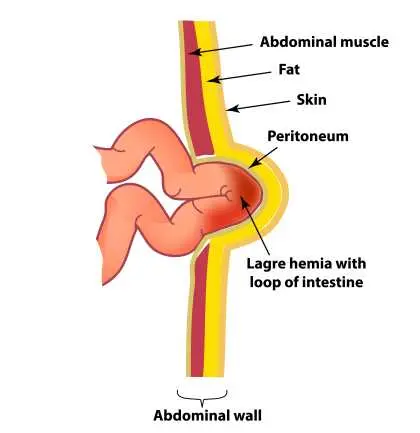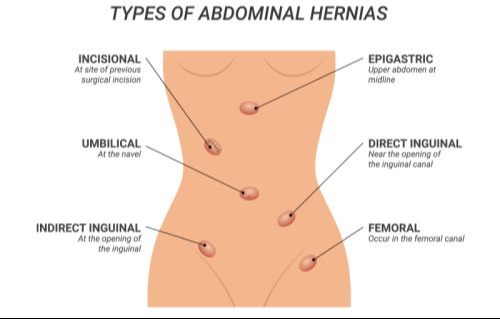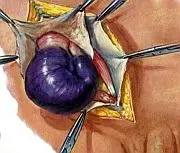What is a Hernia?
A hernia occurs when a part of the bowel, fat, or other abdominal contents pushes through a weakness or defect in the abdominal wall. This creates a visible or palpable bulge under the skin.
It is much like an inner tube pushing through a damaged area in a car tyre — the contents of the abdomen bulge out through the weakened spot in the muscle wall.
This bulge may appear during straining, coughing, or standing, and may flatten or disappear when lying down. Hernias can occur in both men and women and may be present from birth or develop later in life.
Where Do Hernias Occur?
Hernias are classified based on their location. Common types include:
- Groin hernias (inguinal and femoral): The most common type
- Inguinal hernias: occur in the groin where the testicles descend through the abdominal wall
- Femoral hernias: occur at the top of the thigh, next to the femoral vein; more common in women
- Umbilical and paraumbilical hernias: occur around the belly button
- Epigastric hernias: occur between the breastbone and belly button
- Incisional hernias: occur through the scar of a previous surgical incision
- Spigelian hernias: occur on the sides of the rectus abdominis muscles

What Causes Hernias?
Some hernias are congenital (present from birth), but most develop later in life due to factors that increase pressure within the abdomen or weaken the abdominal wall:
- Obesity
- Pregnancy
- Straining during bowel movements or urination
- Heavy lifting without core support
- Chronic coughing (e.g., from smoking or lung disease)
- Smoking (also impairs tissue healing)
- Previous abdominal or groin surgery
- Congenital weakness of connective tissue
- Liver disease with ascites
Symptoms of a Hernia
- Discomfort or aching at the hernia site
- A feeling of heaviness or dragging
- Pain that worsens with activity, lifting, or coughing
- A bulge that becomes more noticeable when standing and disappears when lying flat
Many hernias are reducible, meaning the contents can be gently pushed back into the abdomen. Over time, hernias may become irreducible, meaning the bulge becomes fixed and cannot be pushed back in due to swelling, adhesions, or trapping of the contents, especially if left untreated.
What is a Strangulated Hernia?
A strangulated hernia is a surgical emergency. It occurs when the contents of the hernia (usually bowel) become trapped and the blood supply is cut off, leading to tissue death (gangrene).

Signs of strangulation include:
- Sudden, severe abdominal pain
- Vomiting and nausea
- Abdominal bloating
- Redness, tenderness, and swelling at the hernia site
Do Hernias Resolve on Their Own?
No. Hernias do not go away without surgery. They cannot be repaired by physiotherapy, exercise, or medications. Strengthening core muscles may improve general abdominal tone but does not close the defect in the abdominal wall.
In adults, hernias typically enlarge over time and can become more symptomatic or complicated.
Can a Hernia Be Left Untreated?
Small hernias that are not causing symptoms can sometimes be monitored, especially in patients who are not fit for surgery. However, hernias tend to grow larger and more difficult to repair over time.
Delaying surgery increases the risk of:
- Irreducibility
- Bowel obstruction
- Strangulation
- Increase in the size of the hernia, making repair more difficult and less successful
- More complex surgery with higher complication rates
How Are Hernias Repaired?
Surgery is the only permanent solution for hernias. Hernia repair can be performed:
- Open surgery: through a small incision directly over the hernia site
- Laparoscopic (keyhole) surgery: using small incisions and a camera to guide the repair
A mesh is often used to strengthen the abdominal wall and reduce the risk of recurrence.
What is a Mesh?
A surgical mesh is a synthetic or biological material used to reinforce the abdominal wall during hernia repair. It acts like an internal patch, supporting the weakened area and reducing the risk of the hernia coming back. Meshes are usually permanent and become incorporated into the body's tissues over time.
Are There Alternatives to Surgery?
A truss or support belt may be used in selected patients with inguinal hernias who are not suitable for surgery. This device must be fitted properly and worn consistently to provide any benefit. However, trusses only provide temporary relief and do not treat the underlying problem.
In rare cases, if a hernia is small, asymptomatic, and stable in size, a surgeon may recommend watchful waiting, particularly if the patient has other serious medical conditions that increase surgical risk.
It’s important to understand that all hernias have the potential to grow larger or become complicated over time. Alternatives to surgery should only be considered after consultation with a specialist.










